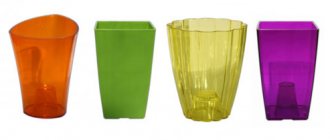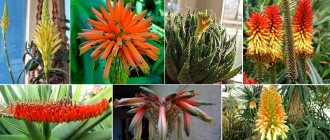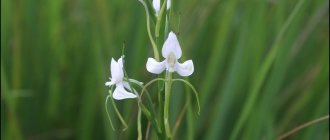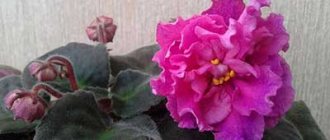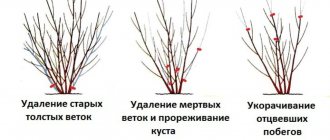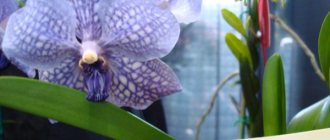The world of violets is so numerous and diverse that even It is not always possible to divide them into thematic groups.
It is especially worth highlighting the collection group or, as they are also called, the exhibition group . This group includes violets with a flower size of 4 cm or more. It is flowers of this size that define the group of large-flowered violets. And although some types of large-flowered violets are quite capricious to care for , their beauty and gorgeous flowering will not leave anyone indifferent.
Varieties of violets with the largest flowers
To make it easier to navigate the world of violets, they were divided into several groups. If you are not interested in violet growing professionally, then you can distinguish three main groups:
- industrial;
- variegated;
- collectible (exhibition).
It is the collection group that is characterized by large inflorescences with flower sizes from 5 to 7 cm , and the largest violets have flowers more than 7 cm.
Their difference from other groups is that almost all types of collectible violets have large double flowers of a wide color spectrum . Also, their leaves have a variety of colors and stand out with their wavy shape.
In addition to the collection group, large-flowered violets also include garden species (Wittrock) , distinguished by a highly branched compact or semi-spreading form, with flowers up to 10 cm in diameter.
Top 10 representatives with a brief description
Selecting the ten largest-flowered violets is very problematic due to their large number. In addition, the size of the flower largely depends on the growing conditions and care for them.
J. Munk selection
"Apache Magic" - huge, semi-double, orchid-shaped flowers of dark purple color. The edges of the petals are strongly wavy with a pencil-interrupted white border.
Dark green, white and pink “show” foliage. Slightly wavy and jagged. The sheet plate is corrugated and quite large in size. It is characterized by a colorful, especially pronounced variegated foliage of a creamy-pink hue.
The rich color of the flowers can, in some growing conditions, take on a dark purple, almost black color. Abundant flowering.
S. Sorano selection
“Arctic Frost” from S. Sorano is an exemplary violet in size, flower and rosette shape, with very large semi-double snow-white star flowers . The rosette is also not small, but it is worth it, giving out such unimaginable exemplary beauty.
The flowers are simply huge, 7-9 cm in size , either simple or semi-double, snow-white in color with an intermittent blue border. The blue color of the border, depending on the growing temperature, may occupy a larger or smaller area of the petal.
The foliage is large, the peduncles are strong, it blooms profusely, resembling a lush cloud.
Selection by D. Denisenko
“Dn-Fleur” is a highlight variety. The opening of the flower appears as a monochromatic light fantasy, which stretches as it grows, with the appearance of a dark lilac edging. The flowers are quite large in the lilac spectrum , simple or semi-double stars.
The leaf is dark green, jagged, quilted, with a red underside. The peculiarity of the variety is that each flower is individual, with its own unique color , which includes all kinds of strokes, lines and the size of a white fantasy on a lilac background.
Has long cap flowering.
Selection LLG/P.Sorano
“Music Box Dancer” - under 8 cm, two-tone, semi- or terry pale pink stars. The pink color gradually turns into a white border. Green, spoon-shaped, medium-sized, upturned foliage.
Quite a large and clumsy socket. Long petioles and uplifted foliage take up a lot of space.
Flowering is very abundant, especially the first one. But large flowers and a bouquet appear after the third flowering, which is quite long, on average about 3 months.
Prefers to be grown in cooler conditions.
Violet Breeder selection
"AB-White Bear" - quite large, up to 7-8 cm, densely double flowers , reminiscent of large white balls. The leaf is green, quilted, slightly wavy in shape. Peduncles are strong and rather large. The multi-layered nature of the flower is admirable.
Depending on growing conditions and care, they may have a slight pinkish tint on a white background . As violet growers say about the size of a flower - “A bear is a bear.”
“AB-Mother's Heart” - very large, up to 10 cm , simple and semi-double, with a wavy white border, dark purple star flowers. The leaves are medium green, slightly wavy, standard.
The socket is compact in size, smooth and neat. Under good growing conditions, the flowers are dark red-burgundy in color, with a pencil white stripe along the edge of the petals . The compact rosette does not allow the placement of a large number of buds, but it accommodates many flower stalks.
Visually, cap flowering is visible after 4-5 flowers have bloomed. Flowering is about a month, frequent and constant.
Selection by K. Morev
“Wedding bouquet” from Konstantin Morev - snow-white, huge, double, multi-layered star flowers, with a slightly corrugated border, sometimes having a greenish tint.
The leaves are all even, standard size, green and glossy. The rosette is semi-miniature, smooth, self-growing. Flowering is abundant, wave-like, loosely bouquet.
The variety is considered one of the best white-flowered Saintpaulia species. There are two types - with rounded and pointed leaves. With rounded foliage they are more demanding to care for.
Selection by Korshunova E.
“EK-Blue-Eyed Russia” is a numerous winner of various international exhibitions. Semi- and double pale blue stars, with slightly elongated and wavy petals, along the edges of which a purple edging stands out.
Exhibition green rosette with pointed leaves. The rosette is large, self-developing . The flower reaches a size of 7 cm and stays on the peduncle for up to 5 weeks.
Cap flowering is regular and long-lasting. Like all varieties selected by E. Korshunova, it prefers a good substrate and coolness . If this is observed, then the border appears.
“EK-Fire Fireworks” is an interesting fiery coral color with a purple coating and a border of the same shade.
Slightly elongated and pointed dark green leaves, red on the underside. The leaves grow slowly on a rather loose rosette.
The flowers are large, reaching 6.5-7 cm and changing color intensity as they grow. Many buds are formed on strong peduncles, which do not bloom together.
It is not fussy about care and produces quite a lot of babies. Loves the summer season and the sun's rays.
Viola Wittrock “Colossus” / COLOSSUS F1
A specially bred series to produce violas with flowers that are gigantic by violet standards. Compact peduncles form a flower well even in fairly hot climates.
Blooms well in spring and autumn, does not grow tall. Looks impressive and beautiful in the garden in different areas. Grows well in cassettes. Retains a beautiful presentation for a long time. Color - tricolor.
What else can they call it?
It is found all over the world. What types of violets are there? Annual and perennial. The most common:
- swamp: usually grows in swamps;
- fragrant: grows in gardens and parks, rare;
- pubescent: can be found in forests and fields;
- field: grows in fields;
- amazing: grows in oak forests.
Night violet - what is it called and what does it look like?
Other names for the plant are Saintpaulia or Uzambara violet. This decorative leaf plant has a poorly developed root system. The leaves are usually green. The color of Saintpaulia flowers comes in blue, violet and purple shades, which is why it is sometimes called tricolor.
Note! To determine whether a flower has enough light, you need to examine its leaves: if they look up, then there is not enough light, respectively, if down, there is enough light.
Features of care
Nuances of conditions of detention
There are no special conditions for growing the bulk of large-flowered violets. The main and most important requirements are for:
- pot size;
- quality and composition of the soil;
- lighting;
- temperature;
- choice of fertilizers;
- compliance with the irrigation regime.
Only some species prefer a slight decrease in temperature for a more saturated flower color or bud formation.
How to water correctly?
One of the main components of successful cultivation of large-flowered Saintpaulia species is compliance with the correct watering regime.
Like almost all types of violets, large-flowered ones are afraid of drying out and waterlogging of the soil. Therefore, you should not overdo it with watering.
The violet should not be over-watered or over-dried.
Advice! It is better to water through a tray or in small portions through the top along the edge of the container, without getting on the flowers or buds.
The frequency and volume of watering depends on several factors:
- season;
- age condition;
- the size of the container in relation to the size of the plant;
- temperature and humidity in the growing room;
- quantity and saturation of lighting;
- quality and composition of the soil.
On average, according to the recommendations of experienced gardeners, watering is carried out:
- 2-3 times a week in the summer;
- once a week in winter.
Do not forget about the quality of water for irrigation. It should be clean, soft and warm.
Lighting
The duration of daylight hours should be about 12 hours per day . But at the same time, direct sunlight on the plant should be avoided , but diffused light should be provided.
If it is impossible to provide the flower with this amount of daylight, it is better to use additional light sources, such as phytolamps.
Illumination of violets.
Important! We should not forget about resting the plant. Daylight hours should not be increased beyond 14 hours.
Nature of feeding
Additional nutrition depends on the growing season and the structure of the leaf blades. At each phase of the growing season, a certain composition of fertilizers should be applied . For large-flowered specimens, additional nutrition occupies a special place.
For full flowering of flowers of this size, the necessary composition of fertilizers, both organic and mineral, containing a full range of necessary micro- and macroelements, should be applied in a timely manner.
The soil of a newly transplanted violet becomes depleted approximately a couple of months after transplantation . From this moment on, you should add the entire complex of substances necessary for the plant for full development, growth and flowering.
In addition to the complex of basic elements - nitrogen, phosphorus and potassium in the ratio NPK: 20:20:20, the composition should also include trace elements: Ca, Fe, Mg, Mo, B, Na, Cu, Z and S.
The first nutrition is applied in the spring after the plant awakens . During this period, complexes with a high nitrogen content are used.
In the phase of budding and rosette formation, fertilizer complexes with a predominance of potassium and phosphorus are required.
Subsequent feeding is carried out with fertilizers for violets with an equal ratio of micro- and macroelements.
Reproduction
For garden large-flowered violet feeds, propagation or reproduction of new planting material is carried out by seeds, cuttings or dividing the bush.
Propagation of indoor violet (Saintpaulia) is mainly carried out by leaf cuttings, rooting them in water or substrate and then planting the children.
Reproduction by cuttings step by step.
There are varieties that reproduce very well, but there are also those that you need to tinker with, ensuring quality with quantity and creating the necessary conditions. But, basically, large-flowered species are propagated in the same way as ordinary standard specimens.
Grandiflora perennial violet - growing from seeds
Viola Wittrock, or as it is also called, garden viola, is a large order, divided into several species:
- monochrome;
- two-color;
- spotted, etc.
Flowering viola.
The varieties are quite winter-hardy , so they are planted and grown in open ground. But in this case, flowering will not occur in the first year. Typically, gardeners grow seedlings to obtain flowering in the first year:
- Seeds are sown in February in a special substrate for sowing violets;
- The seeds are sown in shallow grooves, sprinkled and covered with glass or film;
- The container is transferred to a room with a temperature of about 15°C and a sufficient amount of light, without direct sunlight;
- After 1.5-2 weeks, high-quality seed material germinates;
- No special care is required at this stage; periodic watering is required to avoid drying out of the soil;
- You should also fertilize twice a month.
The first picking of seedlings is done at the stage of two leaves, the second after 2-3 weeks. But, even without a second picking, seedlings can be planted in open ground, thanks to the good survival rate of the viola.
Attention! Further cultivation does not cause difficulties even for not very experienced gardeners.
Errors during cultivation
What to do to prevent flowers from becoming smaller?
Like any plant, violation of care requirements or failure to create the necessary conditions leads to the loss of any qualities. The main reasons for crushing flowers:
- first flowering;
- overfeeding with fertilizers;
- heat;
- insufficient humidity in the room;
- soil quality.
Why do the buds begin to shrink?
Shredding of buds in large-flowered species occurs mainly due to high temperature, dry air in the room and lack of adequate nutrition.
The root system is unable to provide nutrition to the entire plant due to heavy soil
How does a lack or excess of substances affect the outlet?
Large, strong show plants need balance - lighting and nutrition. The food must be suitable for the size of the pot . A large crown requires an appropriate volume of roots. At the same time, overfeeding causes increased crown growth and a “clumsy” rosette.
Therefore, nutrition should be balanced, introduced “for health”, without excesses. Malnutrition leads to delays in growth, development, and lack of flowering.
Important! Each plant is individual. Therefore, care must be individualized.
Fantasy colors
In 1941, the Fantasy violet variety was created, from the name of which the term “fantasy color” . The petals of such flowers are scattered with spots, specks and prints of shades contrasting with the background.
Violet Fantasy.
It is difficult to determine the name of a flower from these patterns, because children do not always retain the characteristics of the mother plant.
You can try to compare with photographs on gardening websites, for example frauflora.ru.

